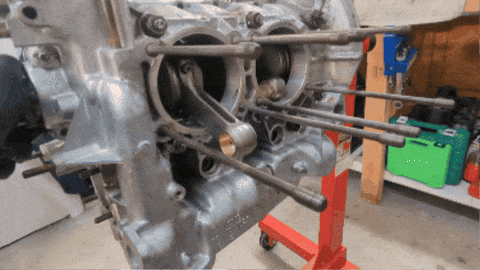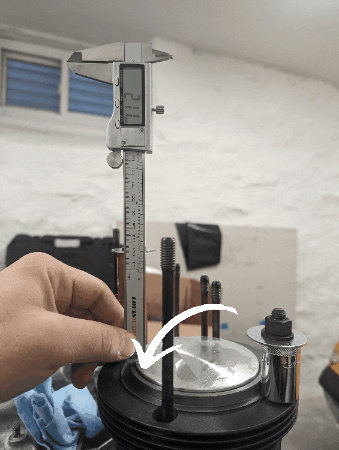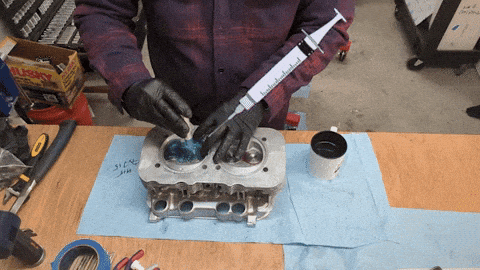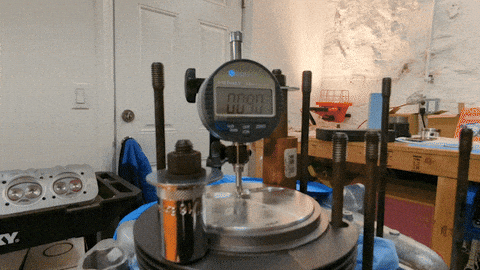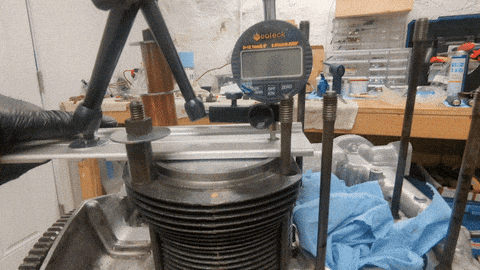QUOTE(VaccaRabite @ Feb 29 2024, 07:08 AM)

QUOTE(vjb206 @ Feb 27 2024, 02:02 PM)

@VaccaRabite very useful info - thank you! I'm just not there yet... Need to take more precise measurements before doing maths. I'm looking to get to an 8.5 or 9 CR (still deciding which is best).
The cyl head is listed at 60ccs, but I will measure them with fluid this weekend.
I'll follow-up early next week with:
• Head CC ccs as measured with fluid
• _Actual_ deck height as measured with a dial gauge (as I said, the one in the picture is just a sanity check)
• Shim / head gasket plan as a result of more detail
Thats the right path.
If you measure deck height along the wrist pin, a dial indicator is overkill. It does not hurt, but your calipers are precise enough for that particular job. You WILL want that dial indicator later though when you set pushrod length. The problem for this application is that its too precise. You are going to struggle to get a repeatable measurement in the thousandths of an inch that you would not as reliably get to the hundredth with your calipers.
For CR, I'd personally target
8.6:1 for a street engine. This lets you run on regular gas.
More importantly, the AA cylinders are iron and uncoated, and will struggle to shed the heat produced by a 9:1+ CR. BTDT.

If you want the higher compression, you are going to want to get your pistons coated and the inside of your heads too. And then do the measurements again, as you will have added thickness to the pistons and reduced the CCs of the heads.
The important thing is to pick a CR and get precise - don't pick a range (8.5-9) pick a number and work to that. The changes from 8.5 to 9 are pretty small in terms of deck height. But it makes a big difference in power output and heat and drivability - especially for longer drives.
Zach
This is good but it doesn't tell the whole story.
Your engine parameters are decided due to expected use and EVERYTHING needs to match.
You've got a 2270 which is where I would want to start.
Pistons are sticking OUT of the cylinders. I want this as well.
It's EASY to shim.
Everyone is advising "come up with a CR and target that which is good advice.
When the engine is functional it is NOT the same compression ratio that you modified for.
Cam selection denotes when the intake valve closes during the compression stroke.
Big cams close the valve LATER than small cams and VASTLY reduce compression ratio.
What you're setting with all of the math is STATIC CR. It is a "make believe" number that doesn't actually produce the same ratio when the rest of the engine is taken into account.
What the engine runs on is DYNAMIC compression and everything plays a part.
Camshaft selection has the biggest effect. Timing of said cam is the second most important step.
Too much intake restriction REDUCES the amount of air that can get into engine.
Too much exhaust restriction REDUCES the amount of exhaust that can exit and can trap excessive heat in the system. This is worse than intake restriction in my book.
Exhaust and intake selection also play a huge part on CR and cam selection.
All of Jake's engines say "must have Billy Badass exhaust". There are really good reasons for this.
Try to run that engine through a normal set of SSI Heat exchangers INSTEAD of a dedicated serious exhaust and you need less compression and less cam.
You will accordingly make less power.
Jake always posted about "balance" and he wasn't talking about stuff the machine shop does. He was talking about having all the parts "matched" for the engines intended use.
I'm prone to build to the outer edge of "streetable" and use the highest-octane fuel that I can easily acquire.
The range of 8.5-9.5 should work OK for a street engine. The higher CR needs a different cam than the lower CR.
What it boils down to is EVERYTHING is important at this level of engine.
You should have had an entire plan before the build.
Another thing that Jake stressed was that he had more money and time in the heads than in the entire short block.
Port flow is stupid important in the above engine. That's the biggest sticking point in my build. A 2270 needs heads that can flow 30-50% more air than a 1.7-2.0l engine.
Good heads get expensive fast...
The current crop of heads are Chinese and can have failures.
Jake says he only uses the bare casting and everything he puts in the heads are "bespoke" parts special to him. This says MUCH!
AA offers the heads BARE for just this reason...
